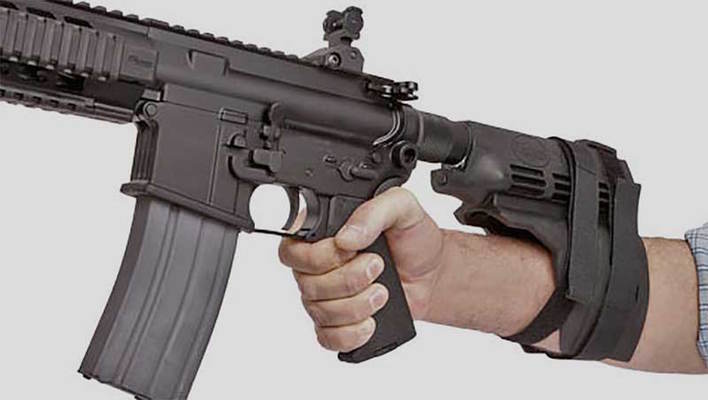
The History of Pistol Arm Braces and Their
Legal Status
Arm braces (stabilizing braces, pistol braces) have been in the news again recently, with President Joe Biden vowing to ban them once again. Arm braces have had a rocky history with the ATF since they were first introduced in 2012. Here’s a rundown of their history and their most up-to-date legal standing.
What is a Pistol Arm Brace?
Arm braces are an aftermarket add-on to AR-style pistols that help to stabilize them. They are NOT buttstocks. Adding a buttstock to a pistol makes it a short-barreled rifle in the eyes of the ATF, which requires a tax stamp to own. Most arm braces are secured to the forearm by velcro. They can, however, oftentimes be shouldered exactly the way that a buttstock would be, essentially allowing them to function as a buttstock would. This functionality comes into play later.
The First Stabilizing Brace
The first pistol stabilizing braces were made by a company called SB Tactical. They were founded in 2012 and before even launching their company, they consulted the ATF for specific guidance on the legality of their product. SB Tactical then partnered with SIG Sauer and Century Arms to create their first stabilizing braces and by May of 2012, they were on the market. Their stabilizing braces became instantly popular, and users began shouldering them, similar to a buttstock when shooting. This led many to question whether the ATF would change their mind on their legality. In 2014 ATF announced that despite how the stabilizing brace was used, it did not change the AR-style pistol into a short-barreled rifle.
ATF Changes Their Mind (Again, and Again, and Again)
Then, in 2015, the ATF abruptly announced that they were reversing course and ruled that how the user uses the brace determines its classification (NFA or non-NFA). When used as intended, with a velcro strap that secures the brace to the shooter’s forearm, it is legal to own. When shouldered as a buttstock, it’s an NFA item. This just added to the confusion because it not only left the classification up to the user, but it contradicted their ruling of just one year prior.
SB Tactical and SIG Sauer initiated a legal battle with ATF, searching for clarification. Finally, in 2017, AFT relented and admitted that a user must physically “reconfigure” the brace in order for it to change categories from pistol to short-barreled rifle. Simply holding it in a different manner does not change the category. Score a victory for SB Tactical.
So braces were legal again, that is until August of 2020 when a firearms manufacturer named Q released an AR-style pistol with an SB Tactical brace called the Honeybadger. Shortly after its release, ATF sent a cease-and-desist letter to Q informing them that the Honeybadger was a short-barreled rifle and required a tax stamp to own. Q moved quickly and issued a $200 refund to all owners (the cost of the tax stamp), and also took legal steps with the ATF to clarify the situation.
With mounting pressure from gun owners as well as Congress, the Department of Justice stepped in and announced a 60-day hold on the decision about braces, pushing the date back past the presidential election.
In December of 2020, DOJ issued a new, 16-page “proposal” on braces, and allowed for public comment before enacting it. The public acted swiftly, with over 60,000 comments on the website in just 17 days, nearly unanimously against the proposal. In a stunning move, the DOJ reversed course and withdrew the proposal. Another win for gun owners.
DOJ still says that changes are “pending”, so that could happen at any time. In fact, the day before writing this, President Joe Biden announced several recommended gun control moves, one of which is classifying stabilizing braces as NFA items. As of this printing, he has not signed any executive orders, but it may happen soon.
